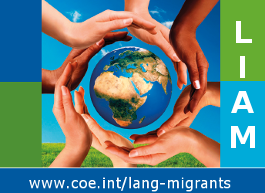European Language Portfolio (ELP)
The European Language Portfolio (ELP) is designed to support the development of learner autonomy, intercultural awareness and plurilingualism. Conceived and developed by the Council of Europe in parallel with the Common European Framework of Reference for Languages (CEFR), it allows users to record their experience of learning languages other than their mother tongue(s) and to assess their language learning achievements against the proficiency levels of the CEFR. In this way it can serve as a complement to certificates and diplomas.
Three components
The ELP has three obligatory components:
- a language passport, which presents a regularly updated overview of the owner’s linguistic profile;
- a language biography, which helps the owner to reflect on his or her language learning and language use, focusing on goal setting and self-assessment, learning strategies, the intercultural dimension of language learning, and plurilingualism (the ability to communicate in two or more languages at any level of proficiency);
- a dossier, in which the owner collects samples of work that reflect the language proficiency he/she has achieved and his/her intercultural experience (the dossier may also be used to organise work in progress).
Links to the CEFR
The ELP is linked to the CEFR in three ways:
- Because language learning is a lifelong process the CEFR recognises the importance of developing learner autonomy because ‘once teaching stops, further learning has to be autonomous’ (CEFR, p.141). The ELP is designed to support the development of language learning skills.
- The ELP is also designed to promote intercultural awareness and plurilingualism, both of which are key concepts of the CEFR and central to the Council of Europe’s language education policy. They play a key role in the integration process.
- The ELP helps learners to relate their learning progress and achievement to the proficiency levels of the CEFR. The language biography includes checklists of ‘I can’ descriptors arranged according to the proficiency levels and communicative activities of the CEFR. The checklists can be used to identify learning goals and self-assess learning achievement, which is periodically recorded in the language passport against the CEFR’s self-assessment grid. Provided learners are required to support their self-assessment with evidence of their achieved proficiency, the ELP can also be used as an assessment instrument in its own right or as a complement to formal tests. It is important to recognize that self-assessment has no place in many educational cultures and needs careful mediation to adult migrants
The ELP and adult migrants
The ELP can support the linguistic integration of adult migrants in three ways:
- Because it is designed to help learners manage their own learning, it is especially appropriate for use in courses that are designed to meet the needs of individual learners. It thus has particular relevance for tailor-made courses.
- Because it is concerned to support the development of plurilingualism, the ELP offers adult migrants a way of recording and reflecting on the languages they know and use in addition to the language of their host country. Making them aware of their linguistic capital and the role that it might play in their integration can be a powerful motivating factor.
- Because it is concerned to support the development of intercultural awareness, the ELP can help adult migrants to achieve a deeper understanding of similarities and differences between the host country and their country of origin.
An ELP website
The Council of Europe’s ELP website provides a wealth of detailed information on the background to the ELP, the development and registration of ELP models, and the use of the ELP in a variety of educational contexts. The website also provides templates and detailed instructions to support the development of new models.
An ELP toolkit
The Council of Europe has developed an ELP for adult migrants that can be adapted to suit the needs of different contexts. It is accompanied by
- a general introduction,
- a guide for teachers that explains how to use each page of the model, and
- goal-setting and self-assessment checklists developed specially for adult migrants.
DL
Related resources
- The linguistic integration of adult migrants and the ‘Common European Framework of Reference for Languages’, 2012, David Little
EN FR
- The European Language Portfolio for Adult Migrants: Learning the language of the host country, 2012, Barbara Lazenby Simpson
EN FR IT
- Linguistic integration of adult migrants and the ELP: an introduction, 2012, David Little
EN FR IT
- ELP for adult migrant language learners: A Guide for Teachers, 2012, Barbara Lazenby Simpson
EN FR IT
- Goal-setting and Self-assessment Checklists, 2012, David Little
EN
- Workshop activities to introduce the CEFR and the ELP, 2012, David Little
EN



